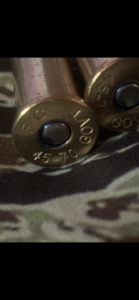North Woods Big Bore

By Tom Kelley
What’s the old saying? “The more things change, the more they stay the same”. Or more accurately, “The more they return to the past.” This is evident in the trend over the last few years back towards lever action rifles. My father was born in 1898. He was a lifelong hunter, like most of us. His one and only deer rifle was a Winchester Model 1894 in .32 Winchester special.
I still have that rifle today and it was the first rifle I ever hunted deer with. I also hunted woodchucks and other varmints with it. Like the thousands of .30/30’s and .35 Remington’s out there, it is still a viable option for Northern New England deer hunts. As a guide, I am seeing many of my clients showing up with lever actions; however, the current trend is toward the big bores, especially the .45/70. I attribute this trend to advances and improvements in ammo performance, and the availability of excellent quality firearms. Companies like Winchester and Marlin have always offered .45/70 rifles and still do. In addition to newer offerings from companies like Henry, these various companies offer everything from traditional wood and blue steel models to Ceracoated tactical models with equipment rails. These choices, as varied as they are, pale in comparison to the choices in ammunition.
The 45/70 ammo
The .45/70 ammo can be had in many bullet weights and designs from 250 gr. jacketed hollow points to 500 gr. hard cast. These choices make this caliber a reliable choice for any game animals from 100 pound whitetails to 2,000 pound African Cape Buffalo. That, my friends, is versatility. There are also two types of loads for pressure considerations. Older rifles like trap door, and falling block actions cannot handle the chamber pressure of modern +P loadings made for modern rifles. These lower pressure options are clearly marked by instructions like, “made for all” rifles. The other loadings say, “for modern rifles only”. The .45/20 has been portrayed in some Hollywood movies as a literal dinosaur slayer or in others as capable of blowing the victim backwards several yards upon impact. In reality, the regular 300 gr. JHP or SP used for deer hunting is very comfortable to shoot. Typical ballistics for this type of load would be a muzzle velocity of 1900 ft. per second with a muzzle energy of 2400 foot pounds. These are very nice to shoot.
Big Bullets
The other end of the spectrum are loads like the 460 gr flat nose Gas Check with a velocity of 1800 fps and 3309 foot pounds of energy. These loads require the removal of your false teeth for fear of loosing them. They will, however, penetrate a moose from end to end. Many detractors cite the rainbow arc that these bullets have as a fault. The truth is that these big bullets are very stable. Once you understand these facts, you can put every round into a 5 gallon bucket at any realistic range with enough energy to dispatch the game. It is also capable of sub minute of angle accuracy out to 150 plus yards. In case MOA is a term you are not familiar with, it means a 3 shot group that is less than one inch at 100 yards, or two inches at 200 yards etc. That’s astounding for a round that is nearly one half inch in diameter. My Marlin Trapper Model with a 16” barrel is extremely accurate and is more than capable of one big ragged hole. What does all of this mean?, Well, a couple of things. The first being that modern rifles with modern ammo and bullets can make the .45/70 a great choice. Second, perhaps some of those old timers knew a good thing when they shot it. Give a .45/70 a try if you get the chance and take a kid with you to the range. Please don’t forget to thank a veteran, they have earned it.
For more articles about hunting, fishing and the great outdoors be sure to subscribe to the Northwoods Sporting Journal.
